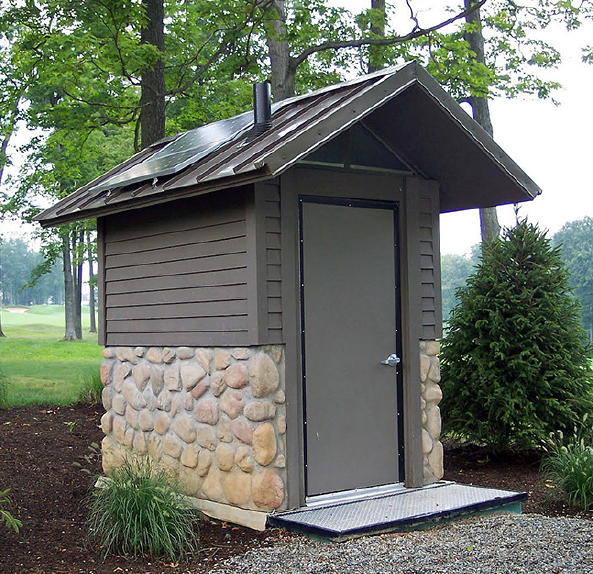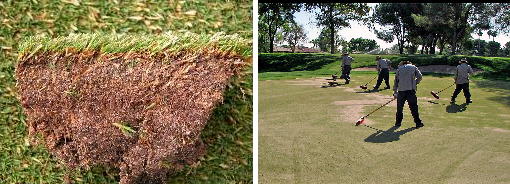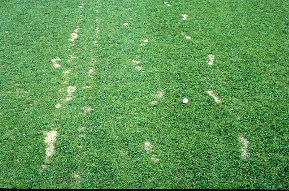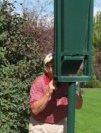The USGA Green Section
Record |
|
|
|
|
January 21, 2011 -- Volume 49, Number 3 |
|
| Nature Calls | Going green? Consider eco-friendly composting toilets
by Bob Vavrek, senior agronomist, North-Central Region |
 | |
The modern composting toilet is a considerable upgrade from the smelly, dark pit-latrines we recall from childhood camping trips. Exteriors can be customized to suit tastes that range from elegant to utilitarian. |
The Rules of Golf address the issue of providing players relief from immovable obstructions, such as cart paths or sprinkler heads. However, they don't address the kind of relief players need on the third or fourth hole after several cups of clubhouse coffee. When nature calls, the call must be answered, so comfort stations need to be available at convenient locations throughout a golf course.
Several types of comfort facilities are available for golf courses. They range from renting a basic portable toilet to the construction of a permanent restroom facility complete with indoor plumbing for toilets and sinks. To find out which option is best for your course read on.
|
| Thatch Legislation |  A Southwest Regional Update A Southwest Regional Update
by Brian Whitlark, agronomist |
 | |
(L) If not properly maintained, thatch accumulates and may increase to levels detrimental to both turf health and putting quality. (R) Labor intensive core aeration, followed by sand topdressing, is essential to both remove thatch and organic matter and create channels for improved water and air exchange in the soil. |
If the highly partisan politicians can agree to pass tax legislation in such a short period of time, then surely the Green Committee and board members at your golf course can agree to pass thatch legislation! Far too many golf course visits in 2010 raised the question -- can we forego aeration this year? Unlike the slumbering economy the past two years, thatch never sleeps. Thatch and organic matter continuously accumulate at the surface and within one to two inches below. Removing organic matter and thatch through proper aeration techniques and verticutting, and dilution through topdressing, are absolutely necessary every year in almost all circumstances. In addition, prudent use of fertilizers is important to produce healthy turf, but be sure to curb excessive thatch accumulation.
Read the rest of this update.
|
| One Result, Many Causes |  A North-Central Regional Update A North-Central Regional Update
by Bob Vavrek, senior agronomist |
 | |
Some forms of ice, or cold-temperature-induced injury to turf, are relatively easy to diagnose, such as cart and foot traffic across heavily frosted playing surfaces. However, the exact cause of other types of more severe winterkill, such as ice suffocation or thaw/freeze injury, are more difficult to determine. |
Winterkill begets winterkill at many older golf courses across the upper Midwest that have playing surfaces dominated by Poa annua. Courses with greens affected by severe winter injury, typically seed creeping bentgrass into the thin and bare areas. However, the end result is usually an even higher percentage of Poa annua due to minimal bentgrass seedling survival on a green that is kept open to play and aggressively maintained at low heights of cut during recovery. Many of the new Poa plants that germinate from seed already in the greens will likely have less ability to tolerate winter stress versus the older Poa plants they replaced. Consequently, a viscous cycle of winter injury can occur.
Read the rest of this update.
Winter injury on turf is not a new subject. A quick search of the early issues of the Record (then called Turf Culture) yielded an article on this subject written in December of 1936. Read the 1936 article.
|
Layer Up For Extra Warmth - Pine Straw
Adds Protection For Winter Injury Prevention |  A Southeast Regional Update A Southeast Regional Update
by Patrick O'Brien and Chris Hartwiger, agronomists |
 | |
Applying a two- to four-inch layer of pine straw to an ultradwarf bermudagrass putting green before pulling on a lightweight cover offers an additional level of winter injury protection. |
Ice and snow accumulation, followed by a bitter wind and cold air, blasted golf courses in the Southeast during the week of January 8 - 14, 2011, and the forecast this week has called for lows in the single digits in several southern cities. Several superintendents with ultradwarf putting greens have taken extra precautions to reduce the risk of winter injury.
At the Atlanta Athletic Club, home of the 2011 PGA Championship, Kasey Kauf and the maintenance staff on the Highlands Course added a two-inch layer of pine straw directly on top of the putting greens before putting on the lightweight covers.
This same technique of straw plus a cover was implemented by Anniston Country Club Superintendent Russell Nichols on several of his shaded or north-facing putting greens. Russell was interested to evaluate the effectiveness of this technique. On January 8, 2011, soil temperature measurements were taken in the top two inches on the #2 green prior to adding pine straw and the cover. The air temperature was 40 degrees and the soil temperature was 38. Approximately twenty-four hours later, the air temperature was 28 degrees and the soil temperature under the pine straw plus cover increased to 42 degrees. Russell then checked the eighth green, and the soil temperature was 35 degrees. Overall, Russell and the staff were pleased with the results and felt reassured that using pine straw plus a cover offered extra protection. This information is summarized in the table below.
Table 1: Anniston Country Club Winter Cover Observations
|
Green Location and Description |
Date and Time |
Air
Temperature |
Soil Temperature | |
#2 Green Before Straw + Covering |
1/8/11, 8:30 AM |
40 F |
38 F | |
#2 Green, Pine Straw and Cover |
1/12/11, AM |
28 F |
42 F | |
# 8 Green, Cover Only |
1/12/11, AM |
29 F |
35 F |
Read the rest of this update.
|
| Turf Twisters | Frost
by the Green Section staff | |
 Q: During the spring our golf course superintendent has an irritating habit of delaying morning play until the frost has melted on the greens. Is this truly necessary to protect the health of the turf? (Missouri) Q: During the spring our golf course superintendent has an irritating habit of delaying morning play until the frost has melted on the greens. Is this truly necessary to protect the health of the turf? (Missouri)
A: The short answer to your question is yes. The long answer is that ice crystals on the surface of the grass makes them brittle enough to break off at their base when stepped on. In fact, the turf can become so brittle that even a small animal, such as a goose, can cause unsightly damage to the turf.
The Green Section offers a short animation explaining the problems of frost in greater detail. To see this animation, click on the image below.
|
| Green Section Record Archive (digital) | Looking for a previous issue of the Green Section Record?
|
 | |
Looking for something? |
The Green Section Record has been published under various names since 1921 and is composed of an amazing collection of full-text articles and photos. This collection is stored and maintained by the wonderful library staff at Michigan State University in the Turfgrass Information File (TGIF). All past issues of the Record, right up to and including this one, can be accessed free-of-charge by following this link. Search the Green Section Record |
| The USGA Green Section Portal |
A Valuable Resource For All, And It's Free |
Take a minute to visit the Green Section's portal at http://gsportal.usga.org to find information regarding upcoming live webcasts and links to recordings of more than 30 previously-delivered webcasts, and announcements of upcoming USGA Green Section activities, education conferences, and meetings. |
|
|
|
| USGA Green Section
P.O. Box 708
Far Hills, NJ 07931-0708 908.234.2300
| |

©2010 by United States Golf Association®
Permission to reproduce articles or material in the USGA Green Section Record is
granted to newspapers, periodicals, and educational institutions (unless specifically
noted otherwise). Credit must be given to the author, the article's title, USGA Green
Section Record, and the issue's date. Copyright protection must be afforded. To reprint
material in other media, written permission must be obtained from the USGA. In any
case, neither articles nor other material may be copied or used for any advertising
promotion, or commercial purposes.
Green Section Record (ISSN 2156-5813) is published weekly via electronic mail by the
United States Golf Association®, Golf House, Far Hills, NJ 07931.
|
|
|
|
|
|